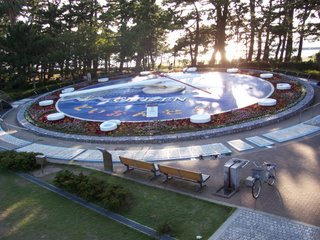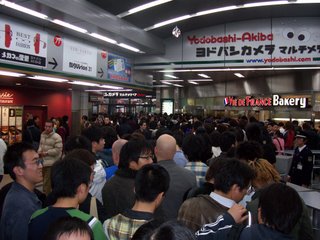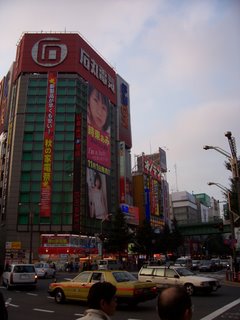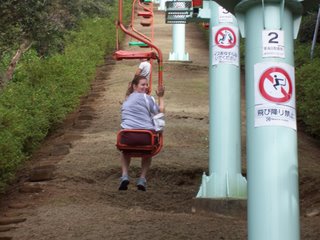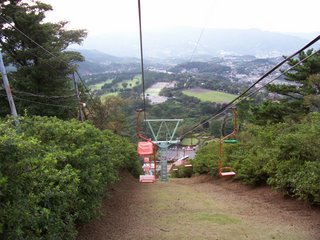I have had requests to talk about the Japanese people, so I will use the event of the Haganasa Dance Festival in Ito to illustrate the cultural flavor of Japan. Our experience thus far is that the Japanese people are overwhelmingly kind-natured, and willing to meet you half-way and then some if you show the slightest effort at trying to integrate.
Many people will tell you that the Japanese are cold and distant. I think this may be the case in business, since the Japanese do not like to make decisions without a great deal of thought, and so they often come across as aloof or cold when negotiating. In their every day dealings, however, I have found the people to be gracious, and welcoming. They value politeness and harmony highly. As such, I have experienced things that would not happen in the U.S. For instance, if you ask a Japanese person if there is something available to do or to make, they will often offer to take you there, make it for you, or do it for you before you have a chance to say that you are only curious. Lisa and I have learned that we have to be careful what we ask about, because we will often find that the person we ask scurries off to take care of the thing we asked about. We find that humbly thanking them brings a big smile to their faces.
Bowing
Bowing is a common sight. Japanese use it in introductions, in saying goodbye, in saying thank you, and in apologizing. There are varying degrees of bow depths, which can be intimidating for an outsider, but the Japanese learn these bows from an early age. Basically, if you are bowing to a senior or superior, you bow low. You do the same if you are thanking someone or apologizing. I have found that it is possible to get into a "bowing loop" because the Japanese will always return a bow, so at times, you can get into an awkwardly long set of bows back and forth. The other night, I saw a group of businessmen leaving a restaurant bowing for like 2 minutes. Then two of the men got into a taxi, and the other two waited on the corner until the taxi pulled off, and continued bowing as the others drove away. People even bow from their cars if you let them enter traffic, or if they cut you off and want to apologize.
Bowing replaces handshaking, and can actually be a quite warm way to greet someone if done properly. That being said, I should mention that Japanese typically reserve physical contact of any kind for family and loved ones. At church, we offer a bow of peace instead of a handshake. If a Japanese person hugs you, you have probably saved the life of his child or something amazing. That being said, many Japanese enjoy trying to imitate Western greetings, and will offer to shake your hand, but as a rule, I don't offer to shake anyone's hand unless they do it first. I bow and say "Hajime Mashite [bow here]" to people my age, or "Dozo[bow here] yoroushiko onegaishimasu" to a superior. The first one is a general "nice to meet you," while the other is a humble request to look with favor on you from that point forward.
One of the major issues that Americans struggle with is the idea that the Japanese do not want to be an inconvenience to anyone, or to be inconvenienced by anyone. This is a very strong theme in the culture, and one of the main areas where it comes into play is with things like parking places. Parking places are very precious here,as there is a limited amount of space. People rent parking places for thousands of Yen a month, so if you park in a space that isn't yours, you can really stir the pudding. I have heard that businesses have feuds over who gets to use parking spaces nearby.
Maybe
In addition to the above, it seems that the Japanese find it awkward socially to say no. Often they will tell you maybe when the answer is definitely no. For example,
Paul: "Is the store open at midnight?"
Japanese person: "Hmmmmmm, maybe?"
EEEEEEEEEEE?
The Japanese have a funny way to express irony and doubt. They have a non-vocabulary sound that they make. It sounds like the letter A (which would be the letter E in Japanese) with a slight amount of U in it. For instance,
Paul: "I love sushi!"
Japanese: "EEEEEEEE?"
Paul: "Oh yeah, they have sushi restaurants all over America."
Japanese: "EEEEEEEEEEEEEEEEEEEEEEEEEEEEEEEEE?"
The sound is not short. Depending on the amount of doubt or irony, they extend it. I have heard EEEs that go on for up to 2 seconds. It is also accompanied by wide amazed eyes. It sounds like this.
Unh
Another sound commonly heard in Japan is the unh. It is often used to indicate agreement or understanding. It is much like our "uh-huh" but shorter and it seems to imply more meaning. I have heard Japanese people pick up the phone and after the initial "Hai. Mushi mushi!" which means hello, the entire conversation is a string of these.
Domo, Dozo, Sumimasen, Gomennasai
Typically, the Japanese consider it rude to lose their tempers in public, so most of the time, you will find that they try to remain polite. This makes it difficult to determine if you have overstepped your bounds. The Japanese get around this by apologizing A LOT. Often, they apologize before they do something. Sumimasen is a word you often hear in Japan. It means many things. It can mean: Excuse me (if you bump into someone or would like to pass by), I'm sorry, or thank you (as in, I'm sorry I made you work so hard to please me). I also hear domo a lot. When combined with arigato, domo is a very polite way to thank someone. But I hear domo all by itself in common parlance. It seems to be a way to apologize and thank others for tolerating one's inconvenient actions. It is often followed by Hai, dozo. Hai dozo is a way of saying, "Don't worry about it, it's a gift to you" You can say Hai, dozo when opening a door for someone or giving them a gift, or when accepting an apology. This is so often said that it takes on a character like the EEEE? It can often sound like, "HaidooozooooooOOO," where the final OOs rise in pitch as they approach the end of the phrase. Gomennasai means basically, "Forgive me" and is used when you are late to arrive, or have caused a large inconvenience, like blocking someone's path with your car.
I have not experienced grudge-bearing here. It seems that if a proper apology is given, the Japanese are extremely tolerant. The only difficulty is knowing the things you may need to make a proper apology for doing. Basically, if you have the ability to treat others as if they are your guests, and try not to inconvenience any of your guests, you can really make a lot of friends here, as they do the same thing.
Garbage
The garbage system here is one of the most confusing things I have ever seen. The Japanese have a lot of enviro-whacko ideas ingrained in them (e.g. Kyoto accord), and as with all environmentalism, it isn't always backed by science. For instance, in a land so convinced that the earth is about to boil, it seems strange that they burn 3/4 of the garbage, much of which is plastics that release CFCs into the atmosphere. That being said, I think the main reason why the garbage system is so strange is because they really don't have a lot of space for landfills. So they separate their garbage into groups: Burnable and non-burnable. But it isn't that simple.
Non-burnable garbage is further separated into recyclable plastics, steel/tin, aluminum, glass, and finally, awkward things (couches, beds, etc.) There are different days of the month when the different types of garbage will be picked up, and it is considered very rude not to pay attention to these days. Burnable trash is picked up 3 times a week, but you can not put it out the night before. It must be placed at the pick up place no later than 8:30 am on the proper day. Also, the bags are specific to the task. You can not put trash out in a regular grocery bag, it must have a label on it that says it is burnable garbage. Most of the grocery stores use these, but some don't. The non-burnables are a different tale altogether. Glass, aluminum, steel, etc. are picked up twice a month on different days. If you have any awkward items, they must be broken down as far as they will go and you have to make special arrangements to have them picked up. This has been by far the most difficult aspect of Japanese culture for us to learn.
This post is becoming too long to talk about the dance festival, so I will get back here and write another one about Japanese fun and arts. Sayonara for now.










 Click on the word "Comments," and the pop-up window that results will have a space for you to type, an identity list, and a submit button. It's really convenient, because every comment you leave will be emailed to us. It also alleviates confusion, as some folks have emailed us that they loved soemthing in the blog, but since it's not tagged to a specific item, I have no idea which post they loved, so that I can write more about that. So, if you really like (or hate) something in the blog, feel free to roll on down to the comment bar and say something about it!
Click on the word "Comments," and the pop-up window that results will have a space for you to type, an identity list, and a submit button. It's really convenient, because every comment you leave will be emailed to us. It also alleviates confusion, as some folks have emailed us that they loved soemthing in the blog, but since it's not tagged to a specific item, I have no idea which post they loved, so that I can write more about that. So, if you really like (or hate) something in the blog, feel free to roll on down to the comment bar and say something about it!

 On the left is a shot from inside one of the ryokan rooms. Tatami mats and low tables typify this kind of space. On the right is a pic of us with part of the Murakami clan. Left to right: Yumi's nephew, Keisuke, Yumi, I, Lisa, and Seiji.
On the left is a shot from inside one of the ryokan rooms. Tatami mats and low tables typify this kind of space. On the right is a pic of us with part of the Murakami clan. Left to right: Yumi's nephew, Keisuke, Yumi, I, Lisa, and Seiji. 


